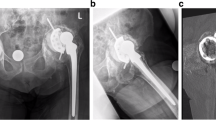Abstract
Introduction: For the reconstruction of acetabular bone defects different types of acetabular reinforcement rings are being used. In clinical practice, these implants showed to some extent good long-term results. In the present work pitfalls and complications after the implantation of acetabular reinforcement rings as well as possible solutions are being discussed. Material and methods: In the first case recurrent dislocation was caused by the malposition of the acetabular component with an impingement of the protruding bone cement and the anterior edge of the acetabular ring as well as muscle insufficiency as a result of the shortening of the leg length. The second case revealed an impingement of the iliopsoas tendon due to a protruding acetabular reinforcement ring. During revision, bone cement was used to smoothen the protruding anterior edge of the acetabular reconstruction ring in order to obtain a relieved sliding of the tendon. Furthermore, we report on the case of a delayed neuropathy of the sciatic nerve after reconstruction of the acetabulum with an acetabular reinforcement ring. Results: Intraoperatively an impingement of the sciatic nerve at the protruding dorsal edge of the acetabular reinforcement ring and the surrounding scar tissue was found. In a further case an aseptic loosening of an acetabular reinforcement ring caused the formation of an excessive granuloma with a large intrapelvic portion. The granuloma led to persisting senso-motoric deficits of the femoral nerve. In summary, based on these clinical cases possible pitfalls, associated with the use of acetabular reinforcement rings, are shown. The mal-positioning and the intra-operative re-shaping of the implant by the surgeon are pointed out as the substantial factors for the occurrence of an impingement phenomenon and total hip instability. Furthermore, in case of an adequate orientation of the cemented polyethylene insert an improper position of the acetabular ring which results in protruding edges has to be considered as a cause of a prosthetic impingement. Conclusion: The cases presented emphasize the necessity of prevention of such pitfalls intra-operatively as well as accurate analysis of implant failures. Furthermore, they suggest explicit preoperative planning before deciding on the strategy of revision surgery of acetabular reinforcement rings.





Similar content being viewed by others
References
Asnis SE, Hanley S, Shelton PD (1985) Sciatic neuropathy secondary to migration of trochanteric wire following total hip arthroplasty. Clin Orthop 196:226–228
Bader R, Steinhauser E, Gradinger R, Willmann G, Mittelmeier W (2002) Computergestützte Bewegungssimulation an Hüftendoprothesen mit Keramik-Keramik-Gleitpaarung Analyse der Einflussparameter Implantat-Design und Position. Z Orthop 140:310–316
Beck T, Walther M, Kessler C, Beck H (1994) The erlangen support ring for management of congenital and acquired acetabular defects intermediate term results of 43 implantations. Unfallchirurg 97:314–319
Berry DJ, Muller ME (1992) Revision arthroplasty using an anti-protrusio cage for massive acetabular bone deficiency. J Bone Joint Surg Br 74:711–715
Bricteux S, Beguin L, Fessy MH (2001) Iliopsoas impingement in 12 patients with a total hip arthroplasty. Rev Chir Orthop Reparatrice Appar Mot 87:820–825
Casagrande PA, Danahy PR (1971) Delayed sciatic-nerve entrapment following the use of self-curing acrylic. A case report. J Bone Joint Surg Am 53:167–169
D‘Antonio JA, Capello WN, Borden LS, Bargar WL, Bierbaum BF, Boettcher WG, Steinberg ME, Stulberg SD, Wedge JH (1989) Classification and management of acetabular abnormalities in total hip arthroplasty. Clin Orthop 243:126–137
Gill TJ, Sledge JB, Muller ME (1998) The Burch-Schneider anti-protrusio cage in revision total hip arthroplasty: indications, principles and long-term results. J Bone Joint Surg Br 80:946–953
Grant P, Roise O, Ovre S (2001) Obturator neuropathy due to intrapelvic extrusion of cement during total hip replacement—report of 2 patients. Acta Orthop Scand 72:537–540
Ha YC, Ahn IO, Jeong ST, Park HB, Koo KH (2001) Iliacus hematoma and femoral nerve palsy after revision hip arthroplasty: a case report. Clin Orthop 385:100–103
Haentjens P, de Boeck H, Handelberg F, Casteleyn PP, Opdecam P (1993) Cemented acetabular reconstruction with the Müller support ring. A minimum five-year clinical and roentgenographic follow-up study. Clin Orthop 290:225–235
Harris WH, Crothers O, Oh I (1977) Total hip replacement and femoral-head bone-grafting for severe acetabular deficiency in adults. J Bone Joint Surg Am 59:752–759
Knahr K, Krugluger J, Pluschnig U (1999) Periphere Nervenläsionen nach Hüft-Totalendoprothese. Z Orthop 137:140–144
Leinung S, Schonfelder M, Wurl P (2002) Inflammatory pseudotumor of the ileopsoas muscle with femoral paralysis caused by massive metal abrasion of a hip endoprosthesis. Chirurg 73:725–728
Mittelmeier W, Rechl H, Peters P, Gradinger R (1998) Erfahrungen mit Becken-Endoprothesen. In: Reichel H, Hein W (eds) Maligne Knochentumoren: Aktueller Stand der Diagnostik und Therapie. Logos, Berlin, pp 131–145
Oleksak M, Edge AJ (1992) Compression of the sciatic nerve by methylmethacrylate cement after total hip replacement. J Bone Joint Surg Br 74:729–730
Pradhan R (1992) Planar anteversion of the acetabular cup as determined from plain anteroposterior radiographs. J Bone Joint Surg Br 81:431–435
Schatzker J, Wong MK (1999) Acetabular revision. The role of rings and cages. Clin Orthop 369:187–197
Siliski JM, Scott RD (1985) Obturator-nerve palsy resulting from intrapelvic extrusion of cement during total hip replacement report of four cases. J Bone Joint Surg Am 67:1225–1228
Sorensen JV, Christensen KS (1992) Wound hematoma induced sciatic nerve palsy after total hip arthroplasty. J Arthroplasty 7:551
Stockl B, Beerkotte J, Krismer M, Fischer M, Bauer R (1997) Results of the Müller acetabular reinforcement ring in revision arthroplasty. Arch Orthop Trauma Surg 116:55–59
Trousdale RT, Cabanela ME, Berry DJ (1995) Anterior iliopsoas impingement after total hip arthroplasty. J Arthroplasty 10:546–549
Wachtl SW, Jung M, Jakob RP, Gautier E (2000) The Burch-Schneider anti-protrusio cage in acetabular revision surgery: a mean follow-up of 12 years. J Arthroplasty 15:959–963
Author information
Authors and Affiliations
Corresponding author
Additional information
No benefits or funds were received for this work.
Rights and permissions
About this article
Cite this article
Bader, R., Mittelmeier, W., Zeiler, G. et al. Pitfalls in the use of acetabular reinforcement rings in total hip revision. Arch Orthop Trauma Surg 125, 558–563 (2005). https://doi.org/10.1007/s00402-005-0051-z
Received:
Published:
Issue Date:
DOI: https://doi.org/10.1007/s00402-005-0051-z




